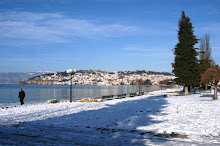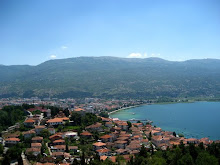
Ohrid is one of the rare cities in the Balkans, such as Thessalonika, Odessa and Dyrachion that had thrived uninterruptedly throughout the classical period. They survived the decline of the classical civilization and continued to live under their new names till the present time. The soil of this ancient city has seen numerous changes of civilization achievements followed by the inevitable falls and rises.
The contemporary city of Ohrid is a descendant of the antique town of Lychnidos. This was confirmed by several Byzantine sources in which it was written "the town is situated on a high hill near the large lake of Lychnidos, by which also the town was named Lychnis, previously known as Dyassarites". The existence of this town is also evident from numerous Roman documents. According to them, Lychnidos was located by the Via Egnatia, the oldest and most important Roman roadway in the Balkans. It started with two routes from Apollonia and Dyrachia and reached to Lychnidos through Candavian Mountains. Long before the Romans came into the region this route had been used as a communicational link between the coast and the internal parts of Illyria and Macedonia. Via Egnatia was the shortest route from Rome to the Eastern Empire.
.
The earliest inhabitants of the widest Lake Ohrid region that can be identified by name were Brigians and Enhelians. Brigians are the same as Phrygians. According to Herodotus, the Phrygians from Asia Minor used to live in Europe in the vicinity of the Macedonians and were called Brigians. After the Troy War they migrated to Asia Minor and changed their name into Phrygians.
Historically, Enhelians have been identified as Illyrians. However, it should be underlined that Herodotus, and some other historians, distinguish them from the Illyrians.
The origin of their name, Enhelians, derives from encheleus -"eel", "serpent", and connects this people with the Lychnidos Lake since it is rich in eel. During the Roman conquests, towards the end of III and the beginning of II century BC, Desaretes and the region Desaretia were mentioned, as well as the town of Lychnidos, Lychnidus and the region Lychnis. Desaretia was a vast region that stretched from Devol in the west to the Macedonian regions of Orestidia and Lynkestidia to the east. Lychnitidia, the region around Lake Ohrid, in the beginning emerged as a separate region outside the borders of Desaretia.
After the Roman conquest, the name Desarets appeared as the joint name of all tribes that lived in the mountainous region inside the area of Macedonia and South Illyria, stretching from the border with Epirus in the south to the Parthynes and Phenestes in the north and Lynkestes in the east.
.jpg)











